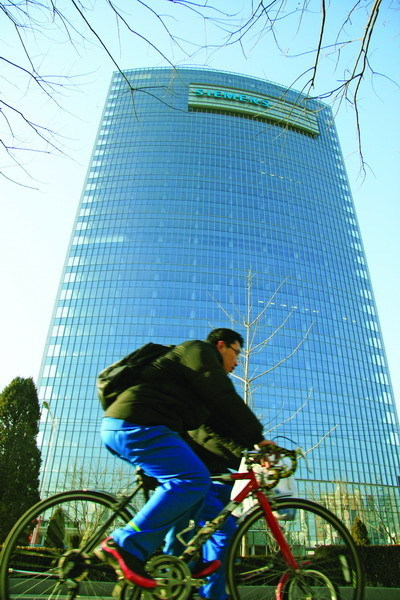German company Siemens looks to environmental products to bolster its fortunes in China
As Siemens evolves into one of the world's largest suppliers of eco-friendly technologies, China will play a much bigger role in the German conglomerate's future growth, says one of the company's senior executives.
China's focus on improving energy efficiency and reducing carbon emissions may help the country surpass the United States as the company's top overseas market in the coming years, says Cheng Meiwei, CEO of Siemens Northeast Asia.
"China is the second-largest overseas market for Siemens, right after the US. With such strong desire to go green in China, the Unites States' position as our top overseas market is not that unshakable as it was before," he says.
|
 Cheng Meiwei, CEO of Siemens Northeast Asia, whose China headquarters in Beijing is shown above, says China will play a big role in the company's growth. [Photo/China Daily] |
Cheng's comment came not long after the German conglomerate announced on Nov 8 its plan to reduce its costs by 6 billion euros ($7.7 billion), the same day Siemens reported a 7 percent growth in revenue in fiscal 2012, compared with the previous year. It also reported a 10 percent year-on-year decline in new orders.
Although Siemens had one of its best operating results in fiscal 2012 with revenue of 78.3 billion euros, the company said in a news release that it fell behind on its objectives.
To get back to reaching its goals, the company recently launched "Siemens 2014", a two-year program aimed at raising profit margins across all of its sectors from its current total mark of 9.5 percent to 12 percent by the end of September 2014.
In doing so, the company plans to increase its competitiveness by "restructuring its products portfolio". Environmental solutions and products are one of its expertise.
In fiscal 2011, Siemens said it generated revenue of 30 billion euros with its environmental products and solutions portfolio - an amount equal to about 40 percent of the company's total sales and a 9 percent increase over fiscal 2010.
The company wants to increase revenue from its environmental products and solutions portfolio to at least 40 billion euros by the end of fiscal 2014.
"China's 12th Five-Year Plan (2011-15) is tailor-made for Siemens," says Cheng, who is also president and CEO of Siemens China. "All four business units we have can cater to the needs of China in terms of sustainable development."
Cheng, who joined Siemens in late 2010, says the company's four business units - industry, energy, healthcare and infrastructure - have generated 6.39 billion euros in revenue in China for fiscal 2011. All are equally important in helping China reduce its consumption of energy, increase efficiency and reduce carbon emissions.
He says Siemens has a massive product portfolio, ranging from home appliances, transmission systems and green building solutions to products for high-speed trains and subways.
Siemens' power transmission technology, for instance, helped the 1,400-kilometer transmission system from Southwest China's Yunnan province to South China's Guangdong to experience only a 5 percent power loss.
In its infrastructure and cities sector, its braking technology can help subway systems greatly cut the energy used in frequent stops.
"China can benefit from each of the sectors to go green, and the growth of each sector will benefit from a greener China," Cheng says.
Although it is unclear what percentage of Siemens' 30 billion euros in sales of environmental products is generated in China, Liao Ning, Siemens' chief engineer of building technology in South China, says he has seen strong demand for greener buildings in China.
"When I started to do this in 2008, I had to really push to sell our solutions. But now people are following me, asking if we can help to save energy for their buildings."
He says that for a building with a life span of 30 years, operating and maintaining it accounts for 80 percent of total costs, and the investment on design and construction for the rest.
